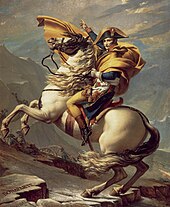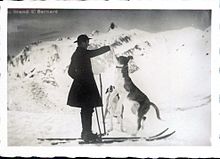Hospice on the Great St. Bernhard
The hospice on the Great St. Bernhard is a hospice founded in the High Middle Ages by the Augustinian Canons on the Great St. Bernhard Alpine Pass ( Latin : Canonici Regulares Congregationis Sancti Bernardi , abbreviation : CRB ).
It belongs to the diocese of Sion and the political municipality of Bourg-Saint-Pierre and is named after Bernhard von Aosta , who also gives the pass his name. He should run the hospice around 1050 together with Queen Ermengarde, the wife of Rudolf III. of Burgundy .
Here, the St. Bernard dog breed was bred as a rescue dog for the search for avalanche victims and made famous worldwide primarily through Barry , who is said to have saved the lives of over 40 people.
history
The hospice of the Augustinian Canons is first attested in 1125. At that time, a church dedicated to St. Nicholas of Myra is said to have been consecrated here. Even then, this included a residential building and a hospital (hence the hospice ). After Bernhard von Aosta (also Bernhard von Mont-Joux or Bernhard von Monton ) was declared a saint by the Bishop of Novara in 1123 , the patronage of the hospice was extended to Bernhard in 1149. The hospice was founded by Bernard together with Queen Ermengarde to take action against the Saracens and bandits who threatened travelers at this important Alpine crossing and who regularly plundered the valuable goods.
The pass itself has been one of the most important Alpine crossings in the Pennine Alps since Roman times . Numerous coin finds from this period testify to the importance of the Roman road. Gods were worshiped here as early as the Iron Age . First was the god Penn a sacrificial site was built, later the Romans, who had substantially improved the road built here a Jupiter consecrated temple . The place where this temple stood is still called Plan de Jupiter and the pass was also called Mons Jovis , which later became Mont-Joux .
There is no reliable information about the first period of the hospice , it is assumed that the hostel was first run by lay people . By the middle of the 12th century at the latest, these were replaced by clerics under the leadership of a provost . The congregation's possessions stretched from England to Sicily, including many houses on major highways of the time. In 1177 there were 78 hospices, houses, priories and churches, in 1286 already 86. Many of these possessions had been given to the canons by important nobles with the intention of consolidating their power on either side of the Alps. The emperors Friedrich I and Heinrich VI stood out in this regard . , King Henry I of England and the Counts and Dukes of Savoy .
In addition to the divine office , hospitality was always central to the canons. Her house was open to anyone who passed the pass, regardless of their social position or intentions. Both smugglers and customs officers found shelter, a roof over their heads and something to eat.
The General Chapter of the Congregation, mentioned for the first time in 1149/1159, sent procurators to control and supervise the properties in order to control the spiritual and secular unity. The existence of the hospice had been threatened several times by disciplinary and economic disintegration. The efforts are especially attributed to Jean d'Arces , provost of the Great St. Bernard and later cardinal , as well as Juan de Cervantes , also cardinal.
The House of Savoy, to whom the monastery owed large parts of its property in the Lake Geneva region, was able to play a key role in determining who was promoted to provost of the congregation. This influence was initially an advantage for the canons, but it became a burden when the hospice was drawn into a long-term secular-ecclesiastical conflict over the right to elect the provost in the middle of the 15th century. Pope Nicholas V had given the House of Savoy a say in the appointment of higher clerics in 1451 in return for Felix V of Savoy's resignation as an antipope . From now on, the Valais tried to gain dominance over the politically important hospice. In the course of the Burgundian Wars , this conflict was exacerbated, as the Valais tens had turned to the Swiss, but the Savoy had turned to the Burgundians. With the victory of the Confederates in the wars, the rule of the tens at the hospice was no longer questioned. In 1752 Pope Benedict XIV divided the provost into a Valais and a Savoy part. The Savoy part was secularized and given to the Order of St. Mauritius and Lazarus assigned.
Founded in 1476, the Morgue des Hospice ossuary on the Great St. Bernhard was walled up in 1950.
St. Bernard dogs
In the course of the 17th century the St. Bernard dogs are mentioned for the first time, which made the hospice famous. It is believed that the first dogs were given to the canons as a donation for services rendered. In 1695 the dogs appear for the first time in a painting, in 1708 Prior Ballalu wrote a somewhat unusual note on the use of the dogs: "In 1700 the Canon Camos constructed a large wheel in which a dog can be locked to turn the spit ...". Other tasks include carrying and pulling loads on the pass and, for the first time, searching for and recovering missing and buried people. Their large physique gives them the freedom of movement they need, even in deep snow. The death toll on the pass is falling significantly.

The hospice was largely spared from the turmoil of the Helvetic Republic. However, Napoleon Bonaparte crossed the pass with 46,000 men in May 1800. The usual hospitality was shown to the exhausted soldiers. The event was central to the later popularity of the St. Bernard dogs, as Napoleon and his officers were extremely impressed by the achievements of these four-legged friends, so that soon the nobility from near and far kept such dogs. Barry I of the Great St. Bernhard was just a puppy that spring that General Berthier wanted to take with him. The dog groom Julius Genoud declined because he had already discovered the young puppy's excellent suitability as a search dog. In his life, Barry is said to have saved the lives of more than forty people, but he was unable to help his own carer when he himself got caught in an avalanche.
In 1801 Napoleon gave the canons the management of the hospice on the Simplon Pass . The necessary infrastructure was completed there in 1831-1835. During the Sonderbund War , things did not go so lightly for the canons: large parts of their property were secularized by the canton of Valais in 1848 , and the compensation for this was more symbolic.
When the pass road over the St. Bernhard was completed in 1905, it brought many new visitors to the hospice. Nevertheless, all guests were catered for free of charge until 1940. Unfortunately, this hospitality was exploited to such an extent that the order was almost driven to economic ruin. Today, to remain at the inn of the canons a mite be paid. On the other hand, the rule still applies that the hospitality in the main building is only available to those who have reached the pass on their own - there is a second, significantly larger building available for visitors in the car.
In 1933, the Augustinian Canons and the Paris Missionary Seminar began building a monastery in Yunnan, China , but were forced to withdraw to Taiwan in 1952 under pressure from the communists .
From 1892 to 1923 the canons ran an agricultural school in Ecône in Valais. This was then reopened in 1951 in Saint-Martin-de-Corléans near Aosta . The school has been called the Institut Agricole Régional since 1982 and, in addition to the former college of Champittet in Pully (until 1998), testifies to the educational efforts of the canons. The provost who heads the confederation has had the privilege of pontificals since 1762 . In 2004 the confederation had 51 members and nine priories in Valais, Aosta Valley and Taiwan.
In 2005 the canons sold the St. Bernard breeding to the Barry Foundation , because the longer the canons saw themselves more and more unable to take on the tasks of animal-friendly breeding and hospitality at the same time . The breeding station for the dogs has since been located in the Musée et Chiens du Saint-Bernard in Martigny , but according to the foundation charter, around half of the animals are on the pass as a tourist attraction throughout the summer. In addition to the living dogs, souvenirs from the famous dogs are of course omnipresent.
Personalities
- The profession as Augustinian canon made 1935 in the hospice on the Great St. Bernhard Maurice Tornay .
- François-Nestor Adam (1903–1990), Bishop of Sitten from 1952 to 1977 , was a novice (from 1927), lecturer in theology and philosophy and novice master (1928–1932) and provost (1939–1952).
- Saint Louis Martin (1823-1894) wanted to enter the hospice as a canon as a young man, but was turned away because of his lack of knowledge of Latin.
- The general provost of the congregation has been provost Jean-Michel Girard since 2014 , who was elected Abbot Primate on October 11, 2016 in Assisi by the Primate's Council of the Confederation of Augustinian Canons .
- Without ever having been there, the poet Annette von Droste-Hülshoff wrote her dramatic poem "The Hospice on the Great St. Bernhard", first published in 1838
literature
- Iris Kürschner: Barry - The hospice dogs from the Great St. Bernhard; Barry du Grand-St-Bernand Foundation. ISBN 978-3-03800-436-3 .
- Daniel Thurre: L'Hospice du Grand-St-Bernard, son église, son trésor. (Swiss Art Guide, No. 556). Ed. Society for Swiss Art History GSK. Bern 1994, ISBN 978-3-85782-556-9 .
Web links
- Gregor Zenhäusern: Great Saint Bernhard (hospice). In: Historical Lexicon of Switzerland .
- Hospice on the Great St. Bernhard on the ETHorama platform
- Congregation of the Great Saint Bernard (German, French, Italian, Spanish, Portuguese, English and Chinese)
Coordinates: 45 ° 52 ′ 8 " N , 7 ° 10 ′ 14" E ; CH1903: 579180 / 79732



